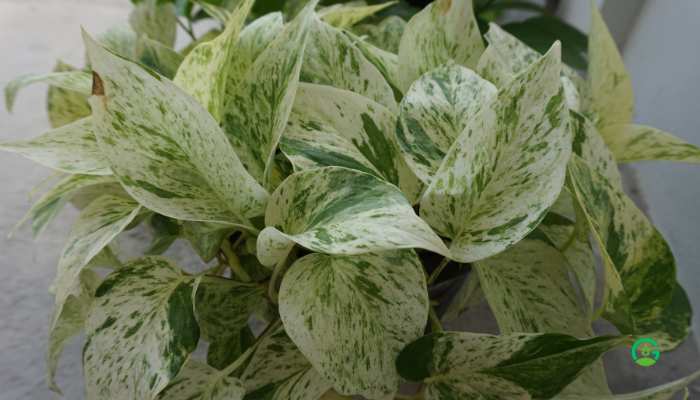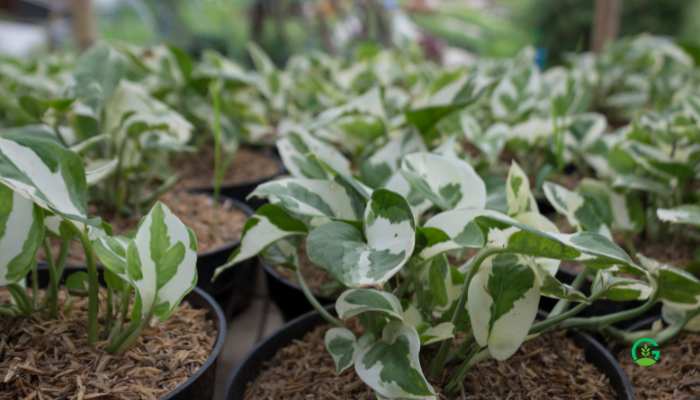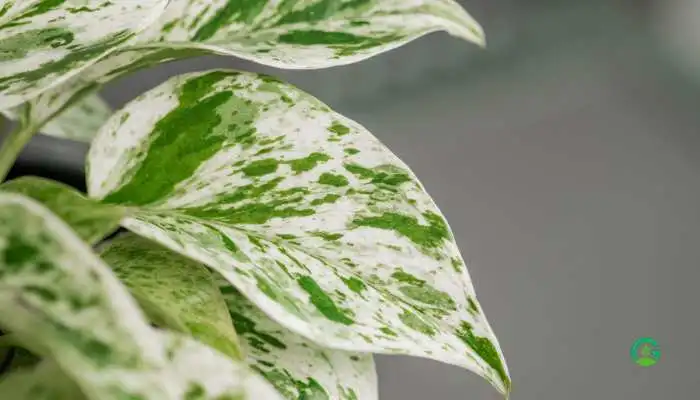Are you looking for an elegant yet easy-to-care-for houseplant to brighten up your home? Look no further than the Marble Queen Devils Ivy. This stunning plant is perfect for both novice gardeners and experienced green thumbs alike.
In this guide, we’ll explore everything you need to know about the Marble Queen Devils Ivy, from its origins to its care requirements, and even some fun facts to impress your friends.
Table of Contents
What is Marble Queen Devils Ivy?
The Marble Queen Devils Ivy, also known as Epipremnum aureum ‘Marble Queen’, is a popular variety of the pothos plant.
Known for its stunning variegated leaves, which feature a mix of green and creamy white, this plant is a favorite among houseplant enthusiasts. Its cascading vines make it perfect for hanging baskets or allowing to trail down shelves.
The Origins and History of Marble Queen Devils Ivy
The Marble Queen Devils Ivy is native to the Solomon Islands in the South Pacific. It was first introduced to the rest of the world in the mid-20th century and quickly gained popularity due to its attractive appearance and ease of care. Today, it is one of the most commonly grown houseplants around the globe.

Characteristics of Marble Queen Devils Ivy
One of the most striking features of the Marble Queen Devils Ivy is its leaves. The heart-shaped leaves are splashed with white and green, creating a marbled effect that gives the plant its name.
This variegation can vary from leaf to leaf, making each plant unique. The vines can grow several feet long, making it a versatile plant for decorating your home.
Benefits of Having Marble Queen Devils Ivy in Your Home
Why should you consider adding a Marble Queen Devils Ivy to your plant collection? Here are a few reasons:
- Air Purification: Like many houseplants, the Marble Queen Devils Ivy helps to clean the air in your home by removing toxins.
- Aesthetic Appeal: Its beautiful variegated leaves can brighten up any space.
- Easy to Care For: This plant is very forgiving and can thrive in a variety of conditions.
- Versatility: Whether you want a hanging plant or one that climbs, the Marble Queen Devils Ivy can do it all.
How to Care for Marble Queen Devils Ivy
Light Requirements
The Marble Queen Devils Ivy thrives in bright, indirect light. However, it is quite adaptable and can tolerate low light conditions. Too much direct sunlight can scorch its leaves, so it’s best to keep it in a spot where it receives filtered light.
Watering Needs
One of the reasons this plant is so easy to care for is its low watering needs. Allow the top inch of soil to dry out between waterings. Overwatering can lead to root rot, so it’s better to underwater than overwater. If the leaves start to droop, it’s a sign that your plant needs water.
Soil and Potting
The Marble Queen Devils Ivy prefers well-draining soil. A standard potting mix with added perlite or sand works well. Make sure the pot has drainage holes to prevent water from sitting in the bottom and causing root rot.
Temperature and Humidity
This plant is quite adaptable to different temperatures but prefers to be kept in a range between 60-85°F (15-29°C). It also enjoys higher humidity levels, but it can tolerate lower humidity found in most homes. If the air in your home is particularly dry, consider using a humidity tray or a humidifier.
Fertilizing Your Marble Queen Devils Ivy
During the growing season (spring and summer), fertilize your Marble Queen Devils Ivy once a month with a balanced houseplant fertilizer. In the fall and winter, you can reduce feeding to once every two to three months.

Common Problems and Solutions
Pests and Diseases
While relatively resistant to pests, Marble Queen Devils Ivy can sometimes attract spider mites, mealybugs, and aphids. Regularly inspect your plant and treat any infestations promptly with insecticidal soap or neem oil.
Yellowing Leaves
If you notice the leaves of your Marble Queen Devils Ivy turning yellow, it could be a sign of overwatering. Make sure you’re allowing the soil to dry out between waterings and check that your pot has adequate drainage.
Leggy Growth
If your plant starts to become leggy with long spaces between the leaves, it might not be getting enough light. Move it to a brighter spot, but avoid direct sunlight that can scorch the leaves.
Propagation Techniques
Propagating Marble Queen Devils Ivy is a fun and rewarding process. The easiest method is by taking stem cuttings. Simply cut a section of the stem with at least one node and place it in water or soil. Within a few weeks, roots will begin to form, and you’ll have a new plant to enjoy or share with friends.
Read More
Styling Your Marble Queen Devils Ivy in Your Home
The Marble Queen Devils Ivy is incredibly versatile when it comes to styling. Here are a few ideas:
- Hanging Baskets: Let the vines trail down for a lush, cascading effect.
- Bookshelves: Allow the plant to drape elegantly from a high shelf.
- Trellis: Train the vines to climb a small trellis for a vertical display.
- Tabletop Decor: Place a smaller plant in a decorative pot on your coffee table or desk.
Fun Facts About Marble Queen Devils Ivy
- Easy to Propagate: This plant can easily be multiplied through stem cuttings, making it a great plant to share with friends.
- Air Purifier: It’s known for its ability to remove pollutants from the air, making your home healthier.
- Pet Warning: While beautiful, this plant is toxic to pets if ingested, so keep it out of reach of curious animals.
Conclusion
The Marble Queen Devils Ivy is a fantastic addition to any home. Its stunning variegated leaves and easy care requirements make it a popular choice for both novice and experienced plant enthusiasts. By following the simple care tips outlined in this guide, you can enjoy the beauty of this plant for years to come.
FAQs
How often should I water my Marble Queen Devils Ivy?
Allow the top inch of soil to dry out before watering. This usually means watering once every 1-2 weeks, depending on the humidity and temperature of your home.
Can Marble Queen Devils Ivy grow in low light?
Yes, this plant is quite adaptable and can tolerate low light conditions. However, it will thrive best in bright, indirect light.
What should I do if my Marble Queen Devils Ivy leaves start to turn yellow?
Yellowing leaves are often a sign of overwatering. Ensure the soil has proper drainage and allow it to dry out between waterings.
How do I propagate Marble Queen Devils Ivy?
Take a stem cutting with at least one node and place it in water or soil. Roots should begin to form within a few weeks.
Is Marble Queen Devils Ivy toxic to pets?
Yes, it is toxic to pets if ingested. Keep it out of reach of cats and dogs to prevent any health issues.

















1 thought on “Marble Queen Devils Ivy: Care Tips and Benefits for Your Home”